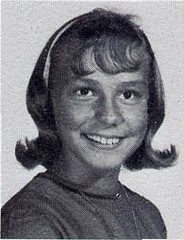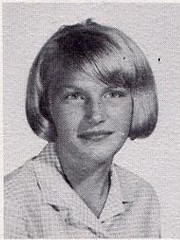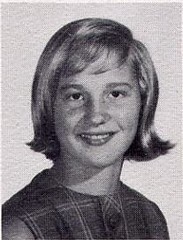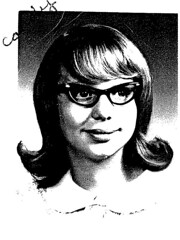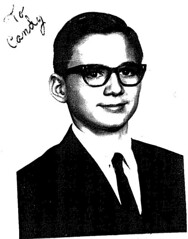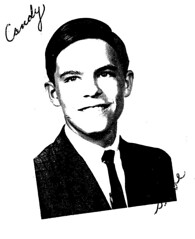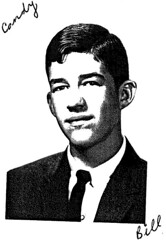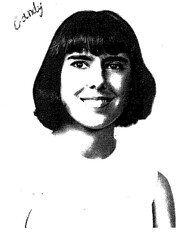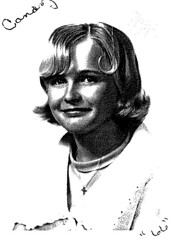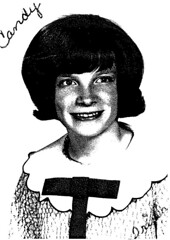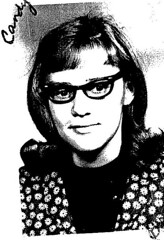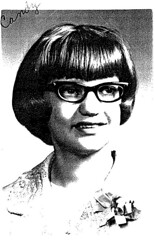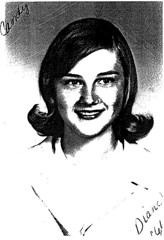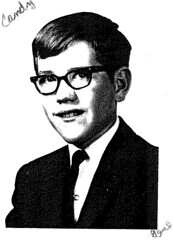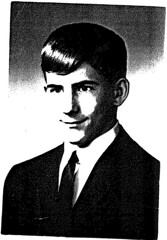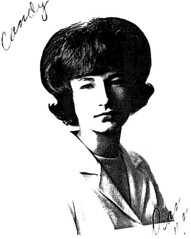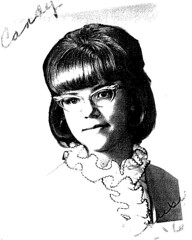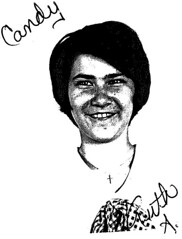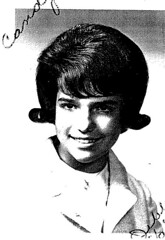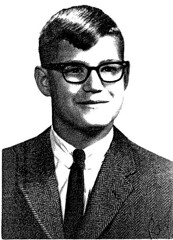During the last weeks of my eighth-grade year in 1966, I wrote a Last Will and Testament, bequeathing various properties to members of the seventh grade. Someone in the school staff typed it, duplicated it, and distributed it to all the seventh and eighth graders. Candy (Safarik) Connery kept her copy all these years, and she mailed it to me recently.
I don't remember whether I wrote this as an elaboration of a previous school tradition or whether I created it as a new idea. I do know that in following years the eighth-grade classes wrote similar bequeathals to the seventh-grade classes, and these were printed in the school newspaper. For example, here is what the newspaper printed in 1968.
Candy, who works as an elementary-school teacher, told me that she introduced this tradition to the classes she taught at her school.
As you will see when you read the entire document below, I was an obnoxious little bragger when I was in eighth grade. Nevertheless, I do think that the document has stood the test of time. After the document, I have added some explanations.
THE LAST WILL AND
TESTAMENT OF
MIKE SYLWESTER
CHAMPION
OF
PERFECTION
I, Mike Sylwester, being of sound mind and body, do hereby bestow my possessions to all my worshippers of me, their idol. The reasons for the passing along of my blessings are as follows: (1) you can’t take it with you, (2) I already have too many good qualities, (3) unless the seventh grade is left some good characteristics it just might turn into a pack of juvenile delinquents, or pirates, or teachers, or even worse, they might turn away from their fetishization of me. So wasting no more time and paper, I shall proceed with the endowing of my God-given gifts.
1.bmp)
2.bmp)
3.bmp)
(Large images of the whole document are on this Flickr webpage.)
To Lawrence Brauer I do hereby leave a cookbook of a thousand ways to make sloppy joes and a picture of me so when I have deceased from the presence of this earth he can bow to it.
To Laura Battermann and to Catherine Giesselmann I leave to each of them a book of Polack jokes.
To Catherine Giesselmann I also bequeath a picture showing all my muscles bulging in all their glory to be shared with all other female admirers on demand.
To Mark Glaess I dower my nose, that is to be separated from my face exactly one hour, eight minutes and forty—nine seconds after my death to insure proper freshness, so that he may add it to his already huge collection.
To all seventh graders in common I bequest my great good luck except for Karen Luebbe as she has already enough luck for the whole school to share.
To James Blomenberg I pass along my great speed so that he may run from mobs of screaming, admiring females if he is ever reincarnated as Mike Sylwester for leading a good life.
To the Heitgerd twins, I present equal shares of my modesty.
To all girls sitting behind me in music (Diane Neujahr, Marcia Middendorf, etc.) I leave ankle-length dresses to prevent them from pulling each others dresses up and embarassing pure virgin boys like me.
To Mark Klammer, my perfect equal, I leave 1 / 1,000,000,000,000,000 of a gram of each of my qualities so that he may truthfully boast of being greater than me.
To Mr. Rupert Giesslemann I leave $7.29 to all be spent on tranquilizers for my five brothers and one sister who are not yet in the seventh grade and I also leave him the warning “the worst is yet to come.”
To Ronald Rocker I leave him my height so that he may be approximately 9 3/4 feet tall. This gift has been awarded to him so that he won’t be shorter than Marcia Heitgerd.
To Donna Niemann I present a sign to be worn around her neck being plainly printed with the inscription: “Stay away from me!”
To all seventh-grade girls I leave my muscles and athletic ability so that they may win more volleyball games and please Mr. Giesselmann so that he might get a raise.
To each seventh grader I leave 17¢ to be wisely invested till the 17¢ has grown to $29.58. After the class pools this money and comes out with $1,300.42 it is instructed to build a memorial to me as the greatest St. Johnny ever.
Such endeth the last will and testament of Mike Sylwester. All remaining stuff will be buried at 134.1 degrees longitude and 72 degrees latitude on the western hemisphere. Over this plot grow a cabbage plant. After 18 weeks look under the cabbage leaf and you will find my successor who will be as great as me.
Now I will add my explanations.
The overall context for my writing this Last Will and Testament was that the seventh-grade class at St John School during the 1965-1966 school year was sooooo imature! Although I was in eighth grade, I had frequent contacts with the seventh graders, because our two grades participated together in choir, in sports, in lunches, and in various other activities. In choir, the seventh graders constantly squirmed around in their seats and burped and farted and giggled. In sports, they cut corners when they ran laps and whined about exercising and practicing. At lunch they ate with their elbows on the table and chewed with their mouths open. I could go on and on, but you get the idea. They were sooooo immature, that it was difficult to imagine that they really could even begin the eighth grade after the summer vacation.
When I wrote my Last Will and Testament, my main idea was to give these seventh-graders some encouragement and guidance. I wanted them to believe in themselves despite their blatant immaturity. All of my fellow eighth-graders already had given up completely on the entire, pathetically immature seventh-grade class, but I decided that if I at least pretended to expect some eventual improvement, then maybe at least a few members of that creepy class might begin to make a few baby steps in the right direction.
When all the rest of the eighth-graders had hearts as hard as stone toward the seventh-graders, why did only I have a soft spot in my own heart toward them? Part of the reason was that I was the youngest member of the eighth-grade class and was the smallest boy. The two images below show me posing with my confirmation class (Candy sent me the photograph.)
.bmp)
.bmp)
The bottom image shows me standing between two other runts, John Garmatz and Ann Marie Holtz. The two runts on the outside of this image were public-school kids, I think. (By the way, I had the darkest skin of everyone in my class. Sue Curtis was the girl with the darkest skin. I figured that we should marry and have kids, because I was interested to see how dark our kids' skin would turn out to be. I'll write more about this cosideration in a future article.)
Anyway, because I was relatively young and short, I could look at the seventh-graders and think to myself: There, but for the grace of God, go I. I was able to identify with them and to pity them, not just disdain and mock them like the rest of the eighth-graders did. Of course, I had to keep my kind, sappy sympathy to myself, but I felt I nevertheless might express my secret sentiments indirectly through my Last Will and Testament.
Of course, some of the seventh-graders had touched my heart somewhere along the way, and I never forgot those moments.
I began my Last Will and Testament with Larry Brauer.
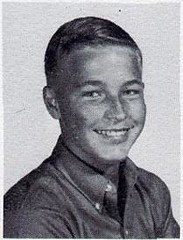
I wrote:
To Lawrence Brauer I do hereby leave a cookbook of a thousand ways to make sloppy joes and a picture of me so when I have deceased from the presence of this earth he can bow to it.
Larry Brauer touched my heart one day when we were in about sixth and fifth grades, respectively. I still was living on Faculty Lane. A bunch of local kids were playing around behind Faculty Lane, on Hillcrest Drive. We had an encounter with a crazy older kid (I think he was a public-school kid we didn't know), and the encounter ended with that kid throwning a rock that hit me in the head. (I don't remember what the argument was about; I think the other kid was just crazy.)
The rock's impact cut my head, and I started to bleed a little. I started to cry, but I bravely tried to stop from crying. It didn't hurt much, but since I could not see the cut on my head, only the blood, I was scared that I was hurt badly.
Larry walked up to me and told me that the cut was not bad, just a little blood, and I shouldn't worry about it. I still was half-crying, so Larry suddenly told me a joke:
Larry: Hey, do you know what's the happiest day of the year?
Me (sniffling): I don't know. What?
Larry: Christmas Eve, because all the girls get a free goose!
Then Larry burst out laughing. I didn't know what it meant that all the girls got gooses, but I did figure out that it was something naughty, so I burst out laughing too and got over my worry about my injury.
I had not known Larry much before that day, but from then on I knew and appreciated that he was an extraordinarily funny and jolly person. When I was in his company, I always watched what he would say and do. His laugh was infectious, so all he had to do was to laugh, and I would laugh too.
The last year or two when I was in St John School, I had two running jokes with Larry. One joke involved Sloppy Joe sandwiches. I don't remember exactly what the joke was, but we talked repeatedly about how much we loved to eat Sloppy Joe sandwiches.
.jpg)
The other running joke involved us doing a little bow toward each other when we met. It was a Chinaman bow. We each held our two hands on our belly and locked the two hands' fingers together and then grinned and bowed slightly to each other. I don't remember how or why that little ceremony between us got started, but it lasted for many months.
Anyway, that explains why my Last Will and Testament began with Larry Brauer and about how, after I was gone from St John School, he still would be able to bow to a book of recipes of Sloppy Joe sandwiches instead of bowing to me. Larry probably has forgotten all all of this, but it still is part of my memory.
Many years later, when I was married, I used his girls-and-gooses joke often with my first two wives. (My third wife is Lithuanian and would not get the joke.) When my wife would get very angry with me about something and would get into a state of holding a constant grudge and giving me the silent treatment, I would approach her cautiously and ask, "Hey, do you know what's the happiest day of the year?" That is all I would have to say, because she immediately would burst out laughing, despite her fury. This same trick worked very well on both those wives.
Then my Last Will and Testament addressed Laura Batterman and Cathy Giesselmann:
To Laura Battermann and to Catherine Giesselmann I leave to each of them a book of Polack jokes.
To Catherine Giesselmann I also bequeath a picture showing all my muscles bulging in all their glory to be shared with all other female admirers on demand.
They were a typical pair of seventh-grade girls -- cute but dopey -- who hung out together and sometimes wandered into my orbit. I told them Polack jokes to make them laugh.
How can you tell you're at a Polack wedding?
The bride has braided armpits and everyone is wearing clean bowling shirts.
I myself had a more sophisticated sense of humor, based on several years of playing my Smothers Brothers records repeatedly.
Tommy: And then after the wedding, we all went to the conception.
Dick: No, not the conception! The reception!! The reception!!!
Tommy: I must have gone to the wrong room.
When I told Laura and Cathy a Polack joke, then they laughed and even howled, but if I told them a sophisticated Smothers Brothers joke, then they responded with puzzled looks and then hesitant, fake laughs, just pretending to get the joke.
The "picture showing all my muscles bulging in all their glory" was a photo montage that I had created the previous summer, when I had had lots of idle time. I had cut out a photograph of my head and a photograph of the body of a muscle-man from a weight-lifting magazine and then had pasted them together on a sheet of paper. I had cut and pasted the pictures as precisely as I could, so it did look at first glance like a photograph of me with an extremely muscular body. Then I had decorated the margins of the sheet with stars and lines, and I wrote some words at the top and bottom. I don't remember all the words, but the most prominent were MIKE SYLWESTER, SUPER STUD. Then I photocopied the entire sheet, so it looked more like a poster instead of a montage. I then showed the product to my guy friends, and they all got a big laugh out of it.
One day my mother saw my poster lying somewhere in our house, and she was offended by the words SUPER STUD. She thought that made my poster extremely vulgar and told me not to show it around any more. She said: "Do you know what a stud is? It's a male horse used for breeding! Is that what you are labeling yourself for everyone?!"
Since my Mom was so mad about my poster, I did put it away, but of course I did not destroy it. I kept it hidden until late during my eighth grade, when for some reason I felt compelled to show it to Laura and Cathy. Unfortunately, I don't remember the circumstances or their reactions, but apparently Laura reacted one way and Cathy reacted another way. Apparently that is why I bequeathed a Polack-joke book to both Laura and Cathy but bequeathed my muscle picture only to Cathy. The reason for that distinction is lost in my memory.
Then my Last Will and Testament turned to Mark Glaess:
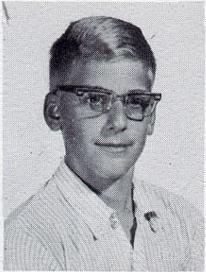
To Mark Glaess I dower my nose, that is to be separated from my face exactly one hour, eight minutes and forty—nine seconds after my death to insure proper freshness, so that he may add it to his already huge collection.
Of course, I found the word dower in a thesaurus. Even now, 43 years later, I am unfamiliar with that word, so I had to look it up. It is a synonym for endow.
In the summer of 1964 the Sylwester family, Klammer family and Stelmachowicz family moved their houses from Faculty Lane to an isolated location on North Columbia Avenue. To the east (front) of our houses was a corn field, to the west a wheat field, and to the north a horse pasture. To the south were a couple, scattered houses occupied by adult couples we didn't know.
When we looked across the cornfield in front of our houses (when the corn was not grown high), we could see the house of the Glaess family, which had moved north of town at about the same time as we did. During the times of the year when the corn was not growing, we could walk through that field in less than five minutes. When the corn was growing, it was easier to ride a bicycle around the field. Anyway, Mark Glaess was our closest neighbor and so he came over to our house a lot to play with the Sylwester and Klammer boys. (The oldest Stelmachowicz kids were all girls.)
Mark was a good friend of me and my brothers. On Sunday evenings he sometimes would stay for our family's Sunday evening meal, which always consisted of ice cream covered with chocolate sauce and cookies. Then he would go home and tell his parents he had eaten lots of healthy vegetables and fruits. He had a good sense of humor, so I felt entitled to kid him publicly about his big nose.
Then my Last Will and Testament turned to Karen Luebbe:
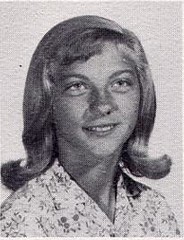
To all seventh graders in common I bequest my great good luck except for Karen Luebbe as she has already enough luck for the whole school to share.
She was a very pretty seventh-grade girl who was a cheerleader. I was on the school basketball team, so she cheered for me whenever I was playing in a game.
.bmp)
That's me kneeling at the lower left corner. You can see the photo in larger sizes at this Flickr webpage.
I did not get to play much in the games. I mostly sat on the bench, and during those times I enjoyed watching Karen do her cheerleading routines right in front of me. I thought she was lucky in life to be so pretty and to be a cheerleader.
Since she was a Luebbe, I assumed she must live on a farm. Therefore I imagined she rode horses and took care of cute farm animals.




There were a couple occasions, not during basketball games, where I happened to be sitting near her, and I tried to engage her in a conversation. I told her I thought she seemed to be lucky in her life. (I didn't tell her she was pretty.) She would just flash me a smile.
She never was talkative with me, but she did not act stuck-up. She was reticent but nice. So, I mentioned her in my Last Will and Testament, in order to tell everyone I thought she was lucky in life. Whether or not she really was lucky was irrelevant. I was just trying to get her attention again for a moment.
Then my Last Will and Testament mentioned James Blomenberg:
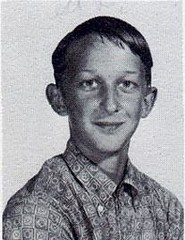
To James Blomenberg I pass along my great speed so that he may run from mobs of screaming, admiring females if he is ever reincarnated as Mike Sylwester for leading a good life.
I don't remember why I mentioned James Blomenberg in relation to running and to girls. He was on the basketball team too; in the team photograph above, he is kneeling in the center. Maybe the mention had something to do with him likewise being a benchwarmer with me during the basketball games and watching the cheerleaders.
James was a funny guy I liked. I wrote about him already in a previous post.
Then my Last Will and Testament paid attention to a gang of four girls (clockwise from upper left -- Margaret Heitgerd, Marcia Heitgert, Marcia Middendorf, and Diane Neujahr):
To the Heitgerd twins, I present equal shares of my modesty.
To all girls sitting behind me in music (Diane Neujahr, Marcia Middendorf, etc.) I leave ankle-length dresses to prevent them from pulling each others dresses up and embarassing pure virgin boys like me.
Since my voice had not broken yet, I sat near a lot of girls in our seventh-eighth-grades choir. Even though I always tried to pay attention and be serious during our choir practices, these pesky seventh-grade girls constantly squirmed around and whispered and giggled. What a bunch of jabbertrons they were!
(Marcia Middendorf had a brother, two years younger, named Mark. About 13 years later, in about 1979, I was standing in line in the cafeteria on Bolling Air Force Base in Washington DC, putting food on my plate, when the guy next to me said, "Hey, aren't you Mike Sylwester? My name is Mark Middendorf." He had noticed my last name Sylwester on the name tag on my Air Force uniform shirt. So, Mark and I had lunch together and talked. He too had joined the USAF, and he was being trained to disarm bombs. We were stationed on the same base, but we never saw each other after that.)
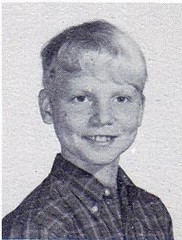
Then my Last Will and Testament addressed Mark Klammer:

To Mark Klammer, my perfect equal, I leave 1 / 1,000,000,000,000,000 of a gram of each of my qualities so that he may truthfully boast of being greater than me.
The Sylwester and Klammer families were neighbors out on remote North Columbia Avenue. Both families had a lot of boys in the same age range, and we always played together.
I always liked Mark Klammer and enjoyed spending time with him. He was funny and fun-loving. He could make a lot of hilarious sounds. He could talk like Donald Duck. He could whistle extremely loud. He had a funny laugh, with a kind of cough in it. He could play the drums well and loudly. I intend to tell some stories about him in future articles in this blog.
Then my Last Will and Testament addressed Ronnie Rocker:
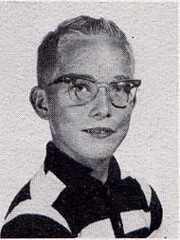
To Ronald Rocker I leave him my height so that he may be approximately 9 3/4 feet tall. This gift has been awarded to him so that he won’t be shorter than Marcia Heitgerd.
Like me, Ronnie Rocker was a small guy whose voice had not broken and who therefore had to sit next to that bunch of bratty girls in the choir. I tried to take this young fellow under my wing and help him learn the ways of a mature eighth-grader.
Ronnie Rocker had one of the coolest names -- RONNIE ROCKER -- in the history of St John School, and his yearbook photo displays the cocky attitude that I helped instill into his personality in preparation for eighth grade.
Finally, my Last Will and Testament addressed Donna Niemann:

To Donna Niemann I present a sign to be worn around her neck being plainly printed with the inscription: “Stay away from me!”
I don't know remember at all why I wrote this. It seems rather cruel now, but I assume it was based on some joke between us at that time.
Gene Meyer wrote:
I laughed out loud concerning your description of Larry Brauer. His laugh was infectious, indeed. Larry was a kindred spirit.
By the way, Larry was a product of a single-mom home. His dad died and his mom had three kids to raise.
His older brother, Denny Brauer (in my brother Alan’s class), became famous as a bass fisherman. He was on the Wheaties Box a few years ago (and naturally PETA protested).

He also had a show on ESPN, Bass Class with Denny Brauer, in 1998. Here is Denny's current web site, and here is another one to look at.




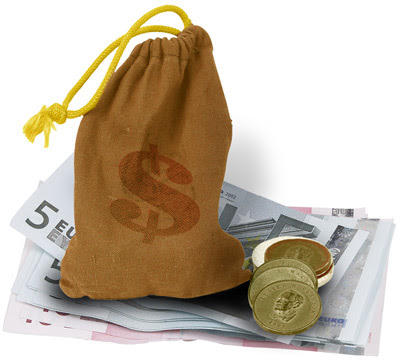



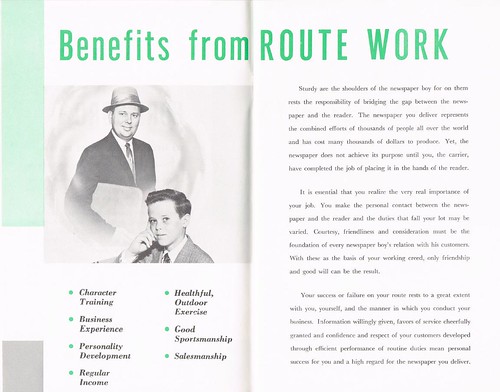

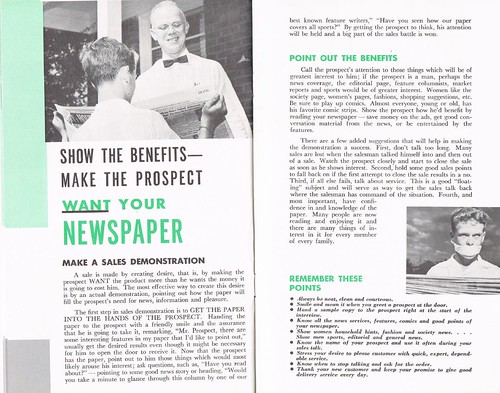
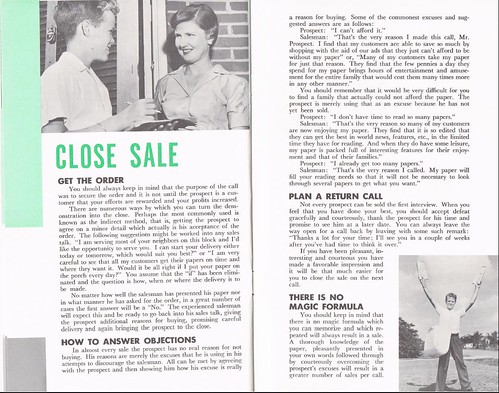
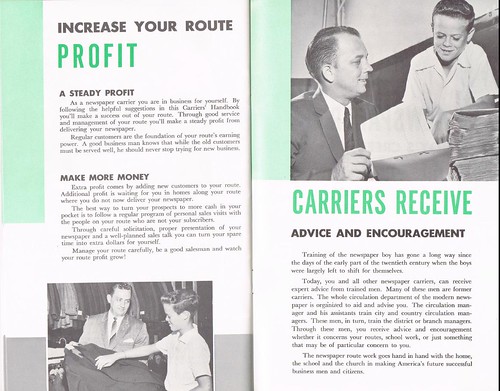

1.bmp)
2.bmp)
3.bmp)
.bmp)
.bmp)

.jpg)

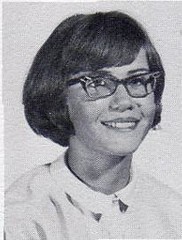


.bmp)





